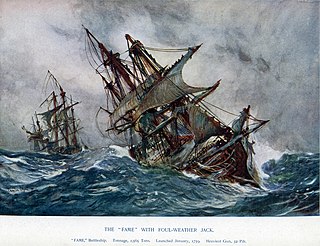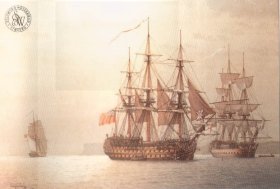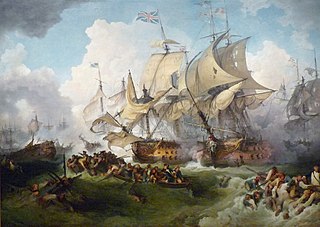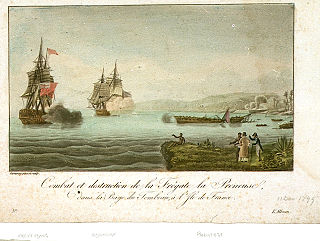
Scipion was a 74-gun French ship of the line, built at Lorient to a design by Jacques Noel Sane. She was laid down as Orient in late 1798, and renamed Scipion in 1801. She was first commissioned in 1802 and joined the French Mediterranean fleet based at Toulon, in the squadron of Admiral Leissègues. Consequently she was one of the ships afloat in that port when war with England reopened in May 1803. She participated in the Battle of Cape Finisterre and the Battle of Trafalgar. The British captured her in the subsequent Battle of Cape Ortegal. In 1810 she participated in the Java campaign, which in 1847 earned her surviving crew the Naval General Service Medal. She participated in the blockade of Toulon in 1813 and was paid off in 1814. She was broken up in 1819.

HMS Fame was a 74-gun third-rate ship of the line of the Royal Navy, in service during the Seven Years' War and the American Revolutionary War.
HMS Surprise was the name the Royal Navy gave to the French Navy's corvette Unité after Unité's capture in 1796. Unité was launched on 16 February 1794. Surprise gained fame in 1799 for the recapture of HMS Hermione. In 1802 Surprise was sold out of the service.

HMS Magnanime was a 64-gun third-rate ship of the line of the Royal Navy, launched on 14 October 1780 at Deptford Dockyard. She belonged to the Intrepid-class designed by Sir John Williams and later was razeed into a 44 gun frigate.

HMS Illustrious was a 74-gun third rate ship of the line of the Royal Navy, launched on 7 July 1789 at Bucklers Hard under the direction of Henry Adams. She participated in the Battle of Genoa after which she was wrecked.

HMS Europa was a 64-gun third rate ship of the line of the Royal Navy, launched on 21 April 1765 at Lepe, Hampshire. She was renamed HMS Europe in 1778, and spent the rest of her career under this name.

HMS Glory was a 98-gun second-rate ship of the line of the Royal Navy, launched on 5 July 1788 at Plymouth.

HMS Resolution was a 74-gun third rate ship of the line of the Royal Navy, designed by Sir Thomas Slade and built by Adam Hayes at Deptford Dockyard and launched on 12 April 1770. The ship had a huge crew of 600 men. As one of the Royal Navy's largest ships she took part in seven major naval battles.
HMS Conqueror was a 74-gun third rate ship of the line of the Royal Navy, built by Israel Pownoll and launched on 10 October 1773 at Plymouth.
HMS Nonsuch was a 64-gun third rate ship of the line of the Royal Navy, built by Israel Pownoll and launched on 17 December 1774 at Plymouth. She was broken up in 1802.

HMS Standard was a 64-gun Royal Navy third-rate ship of the line, launched on 8 October 1782 at Deptford. She was the last of the 15 Intrepid-class vessels, which were built to a design by John Williams.

HMS Diadem was a 64-gun third rate ship of the line of the Royal Navy, launched on 19 December 1782 at Chatham. She participated in the Battle of Cape St Vincent in 1797 under Captain George Henry Towry.

HMS Queen Charlotte was a 100-gun first-rate ship of the line of the Royal Navy, launched on 15 April 1790 at Chatham. She was built to the draught of Royal George designed by Sir Edward Hunt, though with a modified armament.

HMS Ardent was a 64–gun third-rate ship of the line of the Royal Navy, launched on 9 April 1796 at Northfleet. She had been designed and laid down for the British East India Company who was going to name her Princess Royal, but the Navy purchased her before launching, for service as a warship in the French Revolutionary War.

Pégase was a 74-gun ship of the line of the French Navy, lead ship of her class, launched in 1781.

HMS Charles was a 96-gun first-rate ship of the line of the Royal Navy, built by Christopher Pett at Deptford Dockyard until his death in March 1668, then completed by Jonas Shish after being launched in the same month. Her name was formally Charles the Second, but she was known simply as Charles, particularly after 1673 when the contemporary Royal Charles was launched.

Résolue was an Iphigénie-class 32-gun frigate of the French Navy. The British captured her twice, once in November 1791 during peacetime, and again in 1798. The Royal Navy hulked her in 1799 and she was broken up in 1811.
HMS Alcmene was a 32-gun Alcmene-class fifth rate of the Royal Navy. This frigate served during the French Revolutionary and Napoleonic Wars under the command of several notable officers. Alcmene was active in several theatres of the war, spending most of her time cruising in search of enemy vessels or privateers, and escorting convoys. She fought at the Battle of Copenhagen in 1801 and served in the blockade of the French coasts during the later Napoleonic Wars until she was wrecked on the French coast in 1809.

HMS Adamant was a 50-gun Portland-class fourth rate warship of the British Royal Navy. She served during the American War of Independence, the French Revolutionary Wars, and the Napoleonic Wars in a career that spanned thirty years.
Censeur was a 74-gun Pégase-class ship of the line of the French Navy, launched in 1782. She served during the last months of the American War of Independence, and survived to see action in the French Revolutionary Wars. She was briefly captured by the British, but was retaken after a few months and taken back into French service as Révolution. She served until 1799, when she was transferred to the Spanish Navy, but was found to be rotten and was broken up.















